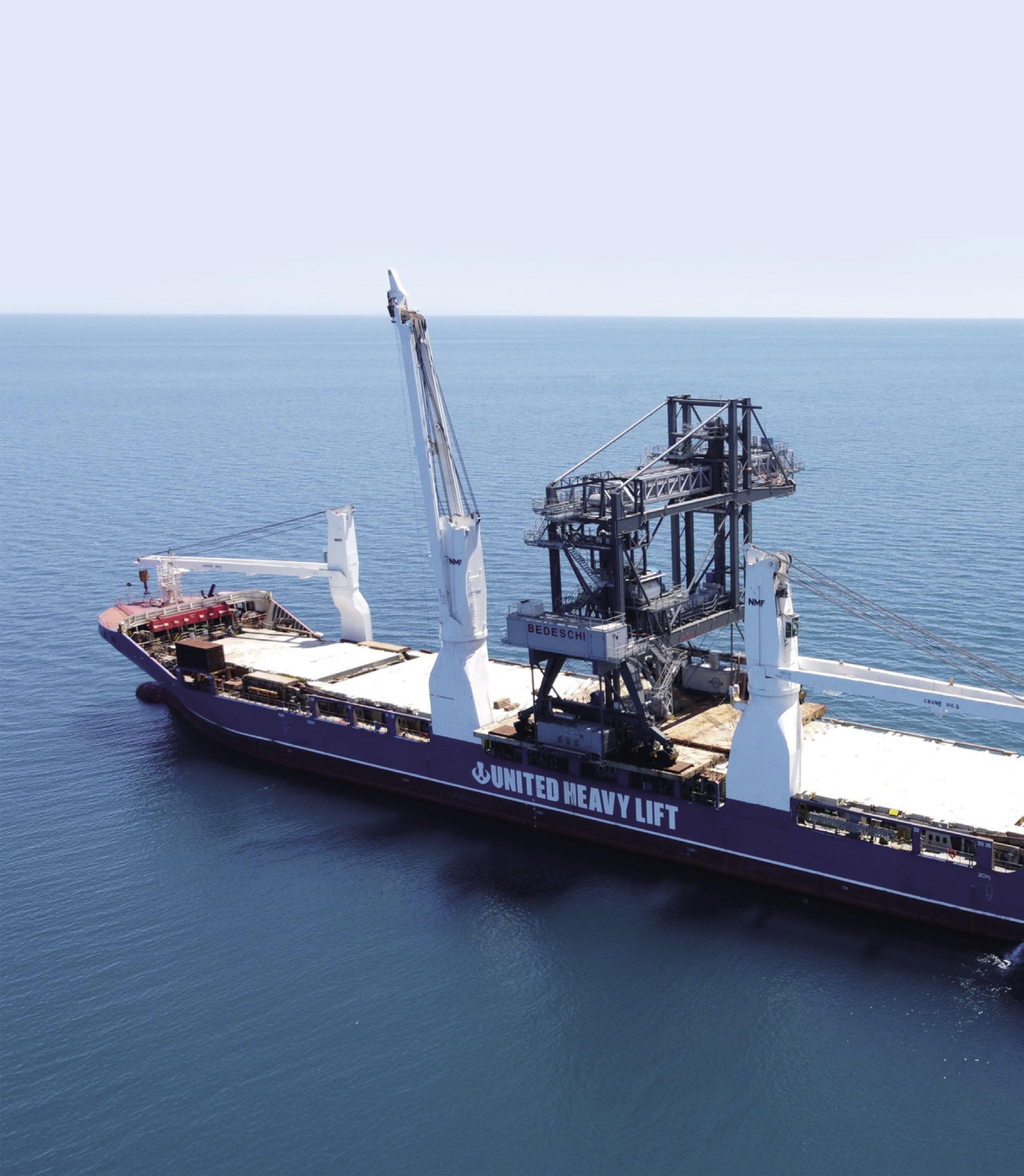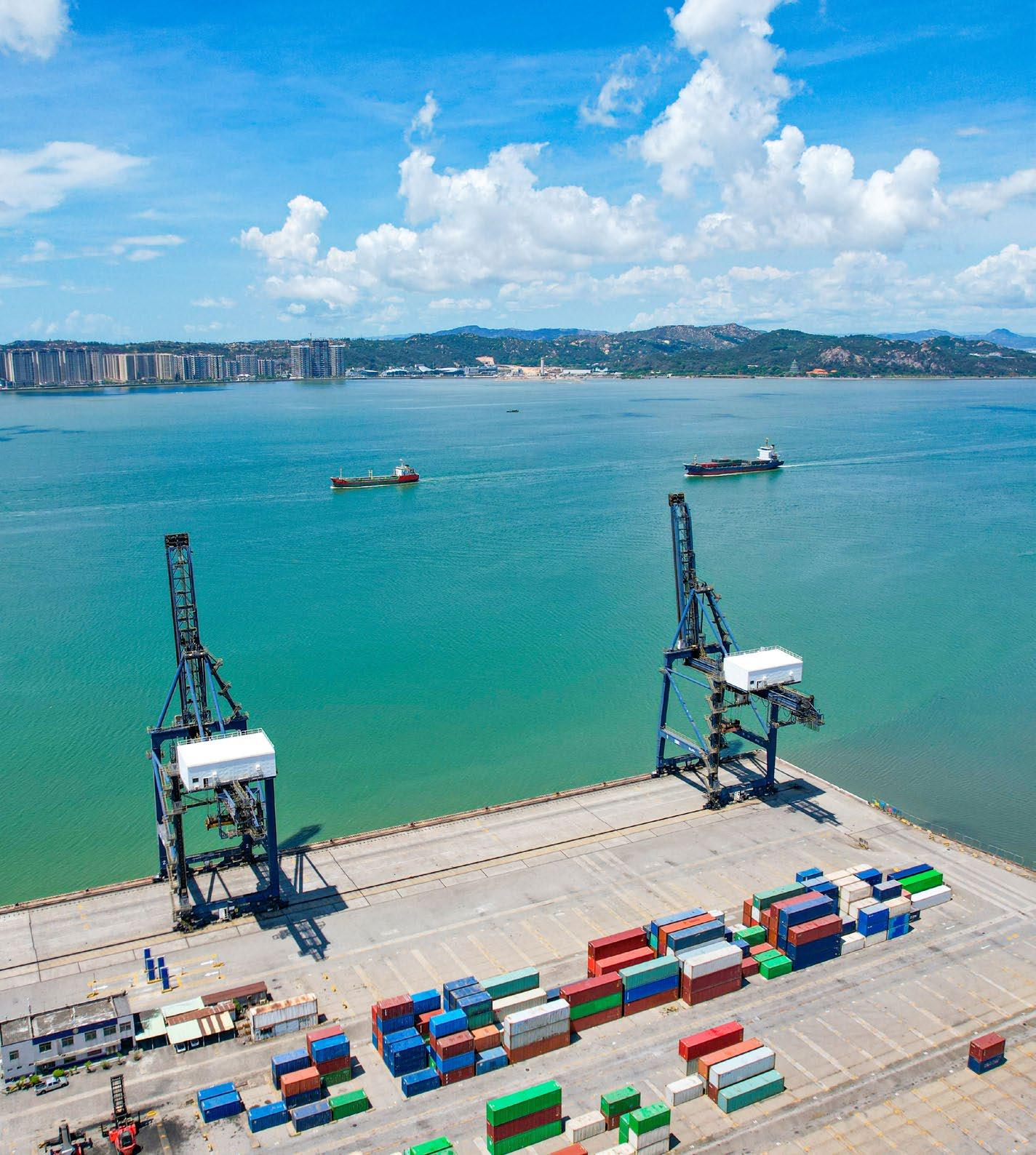
23 minute read
shiploading
from BTI Summer 2022
by Maritime-AMC
PLAIN SAILING
Technology has a key role to play in boosting productivity in ports and ensuring that every part of the supply chain works effectively
Technology supplier Bruks Siwertell has highlighted the role that technology has to play in port modernisation, with specific reference to the Canadian market. While Canadian ports continue to handle hundreds of million tonnes of cargo every year, the authorities have recently been taking a closer look at supply chains and port modernisation – both areas where technology has a strong role to play.
Canada first launched its ports modernisation review four years ago. One example of how modern technology can be used in reaching port targets is to be found at the Canadian port of Saguenay.
As Bruks Siwertell explains, the port is a gateway to northern Québec, and is home to the Grande-Anse marine terminal. Used primarily for the transshipment of general cargoes, dry bulk and bulk liquids, the terminal is also fed material via innovative aircushion conveying technology from Bruks Siwertell.
According to Bruks Siwertell: “The conveyors were brought online in 2020 for forestry industry operator BarretteChapais. They are a feature at its 210,000 tonnes/year wood pellet production
plant, Granule 777, located near to the port. The facility converts processed wood offcuts and residuals from its sawmills into biomass pellets, which are then used as a renewable energy source, offsetting the use of fossil fuels at power stations.
“Integral to Granule 777’s operation is its airsupported conveyor system. With a rated capacity of 800 tonnes/hour for carrying wood pellets, it comprises a 100m-long Bruks belt conveyor and a 250m-long tubulator.
“The belt conveyor carries material from the facility’s two pellet storage domes, before transferring it to the tubulator system, which feeds it to the dock where the pellets are loaded on to bulk carriers bound for Europe.
“Both conveyor types do not use idlers under the belt, instead they rely on pressurised air to deliver low-friction, high-capacity conveying with minimal equipment wear and very low operating costs.”
Part of the technical mix as far as the tabulator is concerned is the use of suspension cable tower technology, which helps to reduce construction costs Bruks Siwertell says.
“Transporting biomass pellets over long distances can be difficult without causing material degradation. The belt conveyor and tubulator minimise this and also, as they are enclosed, control any dust emissions. They are proving to be an ideal solution for BarretteChapais and secure efficient and environment-friendly material transfer to the port.”
Meanwhile, on the shores of Lake Ontario, the port of Oshawa, accessed from the Gulf of St Lawrence through the St Lawrence Seaway, handles dry and liquid bulks, and project and break bulk cargo; the largest, by a considerable margin, is dry bulk, including grain and salt.
The terminal unloads material from smaller vessels from various sources to storage and then loads combined shipments on to larger vessels for export. Handling a significant proportion of the grain transfers for the port’s export facility is an air-supported conveyor system from Bruks Siwertell.
Grain is a particularly delicate cargo, prone to degradation if not handled carefully. The belt conveyor, installed in 2021, is able to preserve the quality of grain shipments, transferring grain from storage silos to the ship loading system.
Like the system in Saguenay, it delivers highly efficient material transfers, with very low operating and maintenance costs.
“Many ports in Canada still unload bulk material with grab cranes,” explains Joanne Turnell, Bruks Siwertell’s Canadian representative. “These have a cargo spillage rate of up to 3%, leading to huge material losses and increasingly unacceptable levels of
BRUKS SIWERTELL EQUIPMENT OPERATES IN ALL HEATS

environmental impact.
“It is no surprise then that I am receiving a lot of interest in Siwertell screw conveyor ship unloading technology,” she adds.
Bruks Siwertell’s enclosed highcapacity Siwertell screw-type unloaders reduce unloading times and vessel costs, but also save all the material losses from spillage and keep the jetty clean and dust-free. Furthermore, the shorter the unloading time, the greater the possibility for the terminal to increase its annual through-put and by that, also increase its profitability, the company points out.
All Siwertell ship unloaders champion environmental credentials, the company says. They have a totally enclosed conveying line from the hold, where the inlet feeder draws material into the vertical screw conveyor from beneath the surface, to the receiving facility, offering close-to-zero dust emissions and eliminating any wasteful spillage.
“This is essential for environmental protection, and particularly advantageous for systems that operate within urban environments,” notes Turnell.
The company has also been supplying wood processing systems to serve Canada’s timber trade which is growing steadily, with wood production exports expected to increase in particular as far as the US and China are concerned.
And when it comes to the world’s ever-changing climates and operational landscapes, the company offers dry bulk handling equipment that is able to perform on a global stage.
Equipment has to be able to withstand extreme temperatures. Bruks Siwertell’s dry bulk handling systems can be adapted to perform in temperatures from as low as -45°C up to +55°C, the company says.
The highest grades of steel have to be used in the extreme cold, along with specially-adapted cabling and hydraulics, and all components, such as electric motors, have to be protected from both the cold and the sun .
For example, the Yara fertiliser plant in Glomfjord, within the Arctic Circle, has a Siwertell unloader that is able to discharge vessels of up to 20,000 dwt. The unloader is equipped with a dustsuppression system and an advanced electrical control unit, including the Siwertell monitoring system, known as SiMon.
Brought online in 2019, the unloader handles demanding dry bulk materials such as various rock phosphates and potash fertiliser at a continuous rated capacity of 600t/h, with a peak capacity of 700t/h. It meets strict environmental criteria, managing high prevailing winds and operating successfully in exceedingly cold conditions.
At the other extreme, Bruks Siwertell customer Kuwait Portland Cement has been operating an ST 490-F railmounted Siwertell unloader for more than two decades in Shuaiba Port, Kuwait City. Its new ship unloader, due for delivery in 2023, will be installed on an existing jetty next to the operator’s older unloader.
Both the new and the old unloader are adapted to operate in Kuwait’s extreme climate. To accommodate predicted temperature rises in the region, the latest unit is designed to withstand ambient summertime temperatures of up to 55°C.
As well as ambient temperatures, other climatic conditions also need

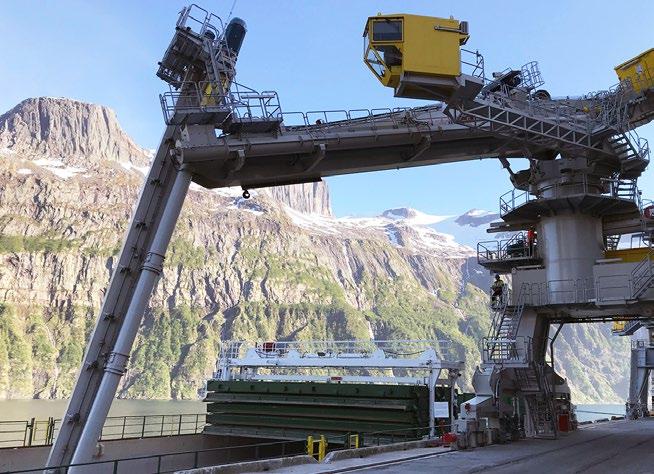
SOME THINK SHIP LOADING CANNOT BE CUSTOMISED. WE THINK DIFFERENT.
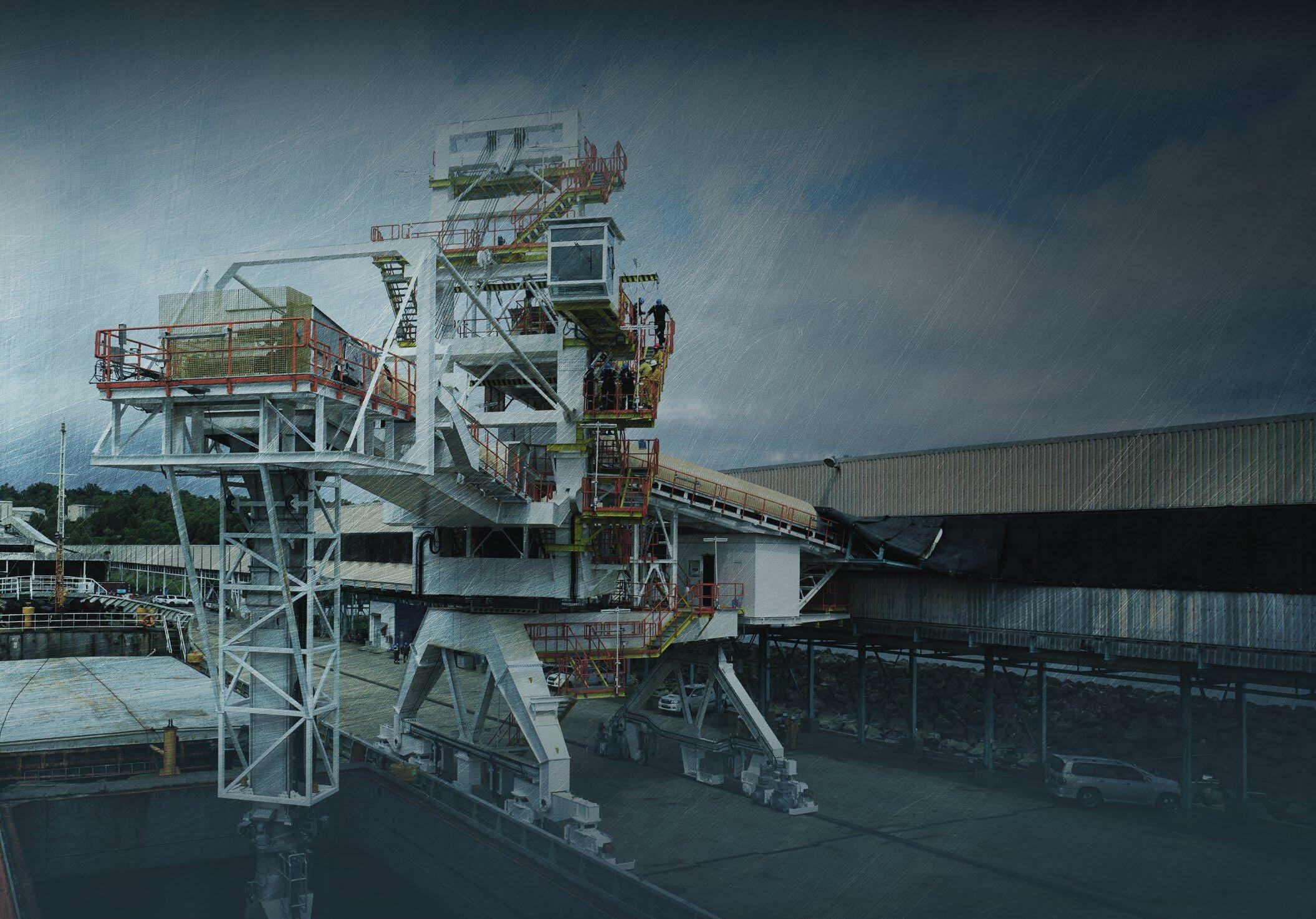
beumer.com
Shiploader_Bulk Terminals Int_178x124mm_EN.indd 1 29.03.22 09:00
consideration. For example, the Yara unloader in the Arctic Circle not only has to withstand the extreme cold, but very strong prevailing winds as well. Other considerations include high humidity conditions and whether the equipment is sufficiently robust to withstand a lightning strike or an earthquake.
Siwertell screw-type ship unloaders and loaders are also totally enclosed, preventing dust emissions and spillage. However, some installations require the next step up in dust prevention with the company incorporating new dust mitigation designs and the use of special high-efficiency particulate air (HEPA) filters.
For example, Swedish company Boliden required a unique material handling solution for its new Boliden Tara Mines terminal in Dublin, Ireland. The ship loading system needed to handle zinc and lead, both are extremely hazardous, and a number of key prerequisites had to be met, including environmental and architectural restrictions.
The installation is located near a popular docklands area and cruise ship port; therefore close-to-zero dust emissions were stipulated in the contract, and very low noise levels. The Boliden system is one example of a highly tailored dust prevention approach; other strategies ensure that all downstream conveyors are covered and have dust mitigation systems at material transfer points.
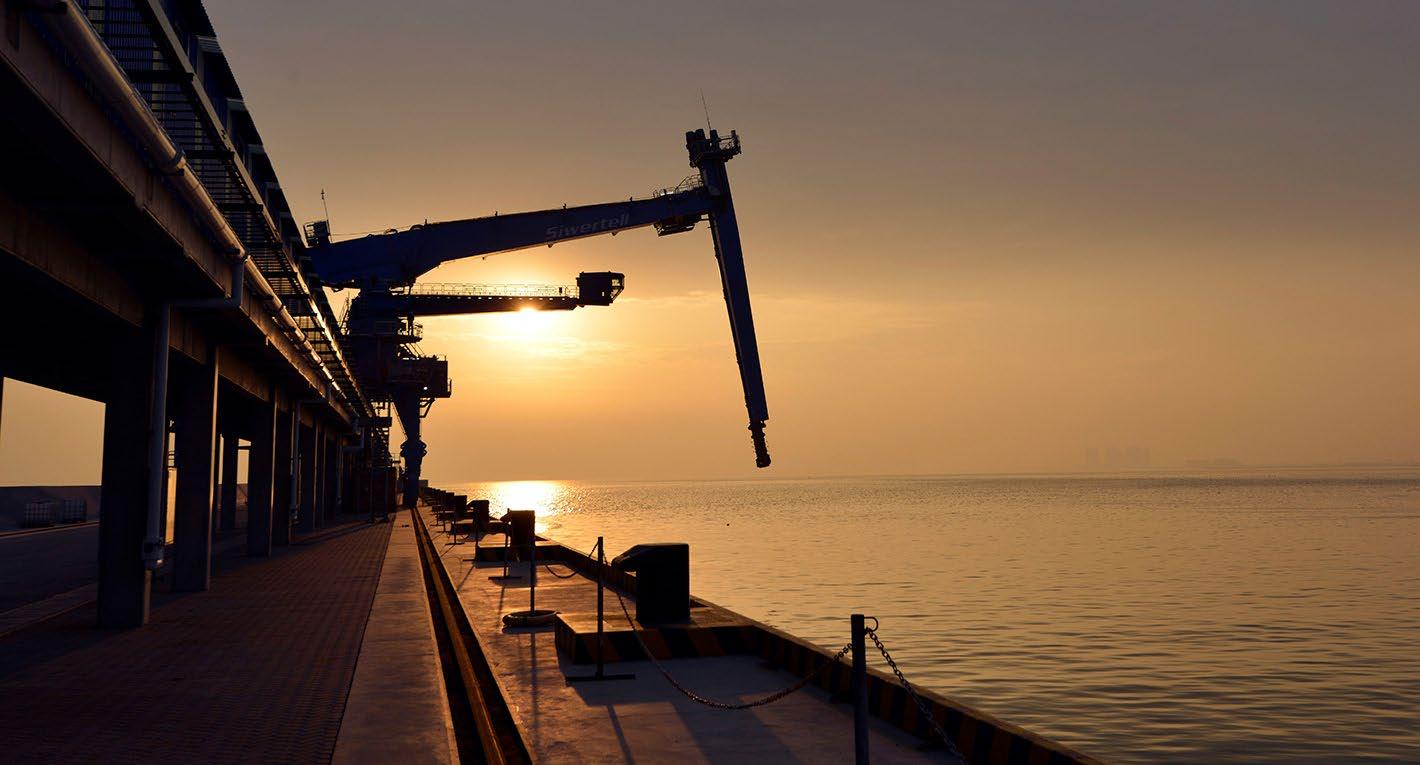
Vessel reporting
Technology company ZeroNorth has revealed its new open Vessel Reporting Platform, which will improve transparency and data quality, enable emissions reductions and lower manual work at sea and on shore.
ZeroNorth has designed the new open Vessel Reporting Platform to help underpin decarbonisation efforts within the shipping industry. The platform is aimed at solving key challenges associated with gathering accurate data from vessels and will boost data transparency.
The new platform will enable masters to ensure data is accurate and complete before reports are sent to shore. It will help to ensure that gathered vessel data offers a true representation of vessel performance, in turn providing the industry’s optimisation solutions with more robust inputs. This will lead to more accurate and powerful fuel and emissions savings recommendations from these types of software.
The web-based platform offers a means of seamless user experience for data entry, saving crew time and cutting onboarding requirements. It will ensure quality data is gathered on the vessel and also enable owners and operators to easily share standardised data across the supply chain.
It works online and offline and can be used simultaneously across different devices, allowing crew to complete and submit vessel reports that are then shared to all stakeholders, avoiding duplication of effort.
The platform’s more than 200 in-platform data validation points will ensure data is entered accurately and completely. For example, the platform will check that data has been entered in the right format or sits within plausible boundaries for normal operations of a given vessel, based on sailing conditions and vessel-specific parameters.
The new Vessel Reporting Platform is open to the industry and is available as a standalone solution that requires minimal system setup. For ZeroNorth customers, the new tool is fully integrated into the ZeroNorth platform to further power up the voyage, vessel, bunker and emissions optimisations generated by the software.
The issue of improving data quality around vessel reports was recently raised by Impact Today, the decarbonisation working group founded by ZeroNorth and other maritime leaders. The working group’s recent Vessel Reporting and Data Quality White Paper called for the maritime sector to create a new data standard aimed at evolving noon reports into holistic vessel reports to support vessel and voyage optimisation – and therefore the industry’s decarbonisation ambitions.
Jesper Bo Hansen, chief revenue officer, ZeroNorth says: “With our launch of our Vessel Reporting Platform, we are taking a big step to solve the key issue of data quality and transparency that is currently acting as a barrier to industry decarbonisation.
“We know how time-intensive vessel reporting can be and understand how critical these reports are for owners and charterers alike. Vessel reports remain one of the best sources of information on ship and fuel performance, so it is only right that we try to find ways to improve and validate data being supplied from ship to shore.
“Our new Vessel Reporting Platform sets out to solve these challenges, providing crew and shoreside staff with a clear, standardised, and easy way to improve reporting so they become more transparent and accountable to counterparties, and, ultimately, are better able to propel their decarbonisation efforts.”
world first for superior
Superior Industries, a US-based manufacturer and global supplier of bulk material processing and handling systems, recently completed design and manufacturing work on what it claims to be the world’s largest telescopic radial stacking conveyor.
The new TeleStacker Conveyor model is a 1,220mm x 64m telescoping conveyor, capable of building 425,000 ton stockpiles. Superior says the recordbreaking stacker will be used to unload dry bulk ships along the Atlantic Coast in Florida.
Operators at the port will take advantage of the TeleStacker Conveyor’s PilePro Automation. This system automatically controls the stacker’s actions while building partially or fully-desegregated stockpiles. Some features include pile volume reporting, maintenance triggers and diagnostics screens.
Ship transfers study
The Oil Companies International Marine Forum (OCIMF) has published a new study analysing ship-to-ship transfers under varying environmental conditions.
Ship-to-ship (STS) transfer operations take place across different geographies and under varying environmental conditions, adding to the complexity and risks associated with such transfers. Despite best efforts, mooring line failures are still a leading cause of incidents, potentially causing harm to people and the environment thus jeopardising the integrity of such transfers.
This information paper, Mooring Load Analysis during Ship to Ship Transfer Operations, aims to support relevant stakeholders in making their own assessments to determine suitable weather criteria and ascertain an appropriate weather window for STS operations.
The study supports KPIs listed under element five of the Ship-to-Ship Service Provider Management Self Assessment, 2nd edition (2020). Previous editions of OCIMF’s STS guide included similar outputs. The current study used advanced mooring line load simulation technology for enhanced assessment of mooring line loads under varying environmental conditions for a variety of ship-type combinations, including liquefied petroleum gas and liquefied natural gas carriers. Download the study for free at: ocimf.org Air system sign up
Clean technology company Silverstream Technologies has reached an agreement with Klaveness Combination Carriers (KCC) to install an innovative new version of its air lubrication system, the Silverstream System, on up to 11 vessels, including three CABU II class and eight CLEANBU class vessels.
The Silverstream System uses a series of air release units (ARUs) in the vessel’s flat bottom to generate a uniform carpet of microbubbles that travel the full length of the hull, reducing friction between the hull and the water and substantially reducing fuel consumption and carbon emissions as a result. Silverstream’s patented technology maximises these net efficiency gains through the system’s low power consumption and highly effective delivery of microbubbles into the boundary layer.
The retrofit installations will commence in early 2023 and take two years to complete.
The collaboration between Klaveness and Silverstream Technologies has resulted in a pioneering solution suitable for any standard tanker and bulk carrier of this size. The deal enables KCC to further enhance the already marketleading environmental performance of its combination carrier fleet. With its capability to carry both types of cargo and other design improvements, KCC’s vessels emit up to 40% less CO2 per tonmile compared to standard tanker or bulk carriers in similar trading patterns – a high performance benchmark that will be boosted by the installation of the Silverstream System.
Noah Silberschmidt, chief executive of Silverstream Technologies, says: “We are delighted to sign this deal with KCC and begin work to retrofit our technology across its fleet. KCC has a strong and well-deserved reputation for being a sustainability leader and a genuinely green-minded innovator, and we are confident that our system will help to boost these credentials even further.
“The deal also proves Silverstream’s ability to take on complex retrofit projects and again underlines the attractiveness of our unique technology to a wide range of shipping segments and vessel operations. It also strengthens our ability to be able to serve unique vessel types and positions us perfectly to scale up adoption of our solution in both dry bulk and tanker shipping.
“Shipping has precious little time to act on its environmental footprint and proven clean technologies like the Silverstream System are one of the only ways that owners and operators can get ahead of the curve. We look forward to further scaling our technology across a range of vessel types and fleet sizes in the near future.”
Engebret Dahm, chief executive of KCC, adds: “Maximising the energy efficiency of our fleet is a top priority for KCC. It is a prerequisite for reaching our decarbonisation targets and succeeding with the future energy transition. We are pleased to conclude the deal with Silverstream and to start the installation of Silverstream’s innovative and proven air lubrification system on two of vessels in 2023, with the intention to roll out the system on a further nine vessels during 2024-25.”
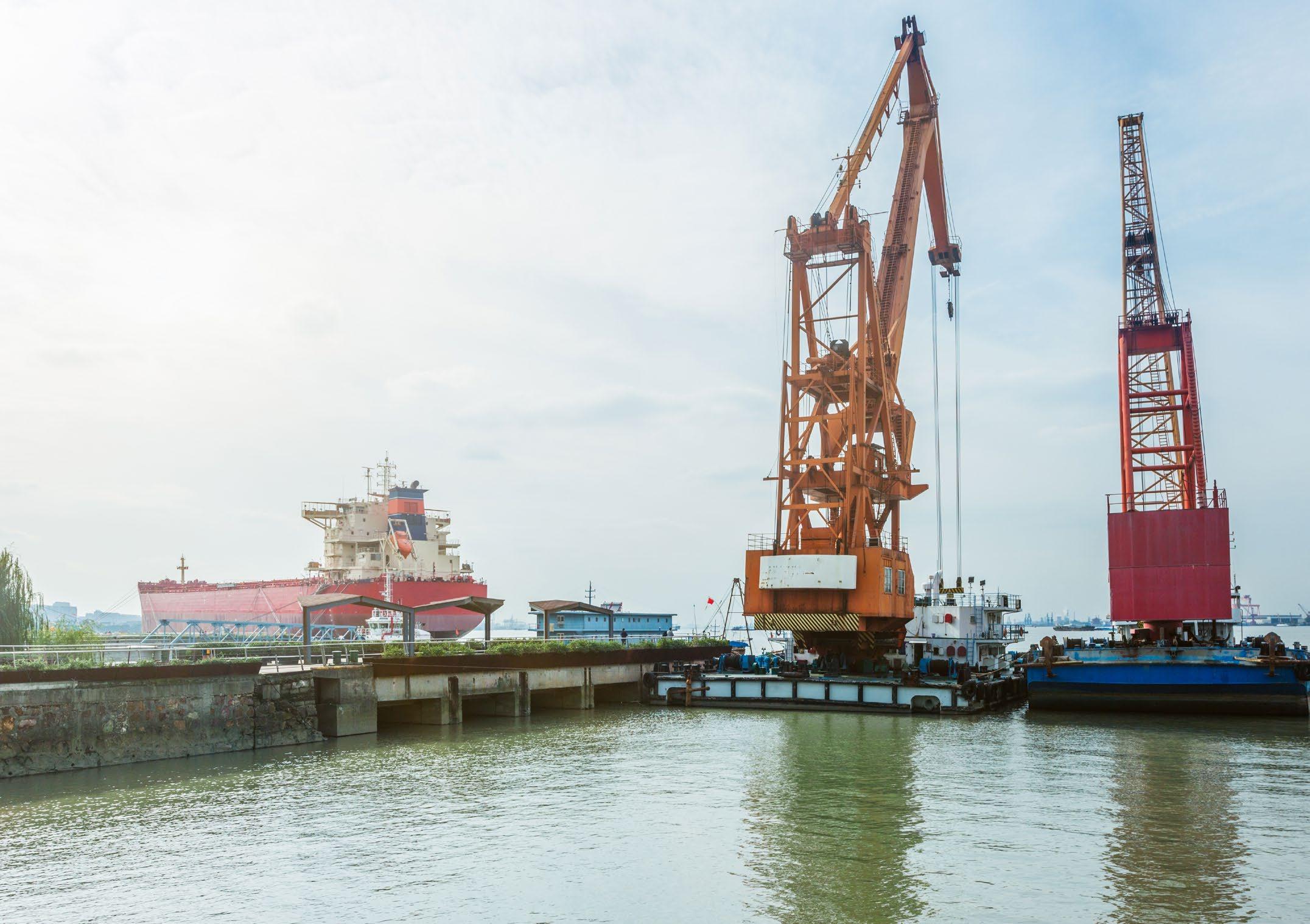
N.M. HEILIG: ENSURING A SMOOTH OPERATION
COMPANY NEWS
THE BRIDGE SECTION WAS TRANSPORTED BY ROAD AND ARRIVED IN THE MIDDLE OF THE NIGHT When a 200m long quay that was more than 100 years old and the loading system on it were in urgent need of replacement, Netherlands-based Walhout Maritime called on N.M. Heilig to ensure everything went smoothly.
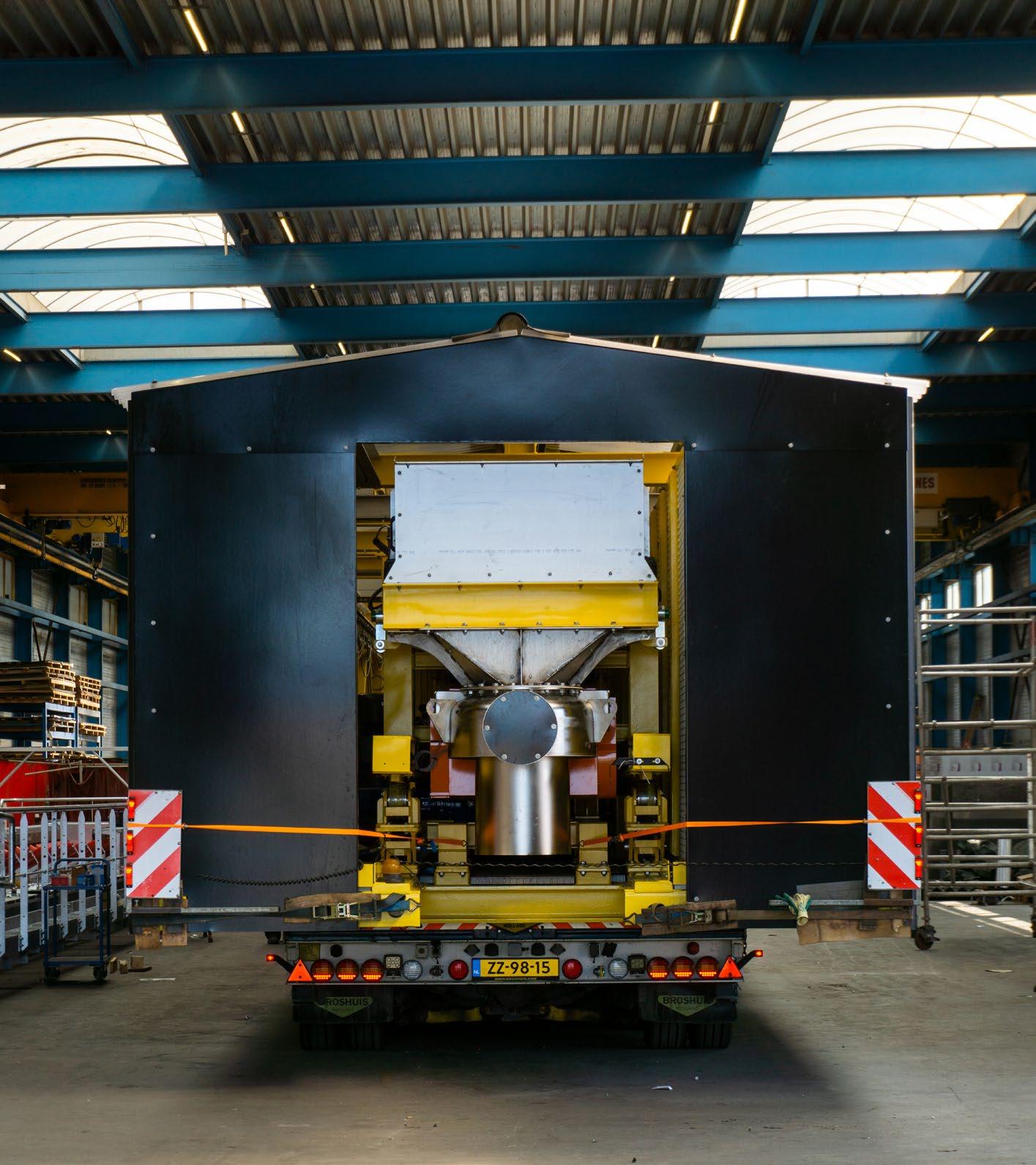
Walhout Maritime specialises in keeping storage and transshipment companies operational by realising or maintaining mooring facilities during quay construction and maintenance. Since these components are the lifeblood of these companies, an integrated approach is necessary.
N.M. Heilig – part of Heilig Group – worked on a new loading portal for fertiliser manufacturer Rosier Nederland at the quay in Sas van Gent, collaborating on the ideal solution for loading and unloading facilities and working out the entire process from design and choice of materials to implementation.
The challenge was that Rosier’s storage and transshipment activities had to continue during the 10-month quay replacement. During this time, eight temporary mooring facilities were used so that construction could continue while ships were loaded.
Once the main construction of the quay was completed with the old shiploader retained, everything was set in motion to dismantle the old loader and install and commission the new loader within two weeks.
In order to carry out the replacement of the loading portal as efficiently as possible, N.M. Heilig constructed a parallel workflow, beginning the construction of the new shiploader as work began on the quay repair. With its large workshop, N.M. Heilig was able to assemble, mount and prepare the whole bridge section for transport.
During the design, the maximum dimensions of the bridge section were taken into account, so that it could be transported on the public highway with the necessary transport guidance.
After four hours, the more than 36m-long, 4.5m-wide and 110,000kg heavy bridge section arrived in Sas van Gent in the middle of the night, where it was lifted and placed the next day using two telescopic cranes. Rosier has been making high-quality fertilisers for 140 years and is active in 120 countries, contributing to sustainable and efficient global food production. The new shiploader loads ships quickly and efficiently for fertiliser distribution and is retractable, extendable and therefore mobile, allowing even or angled loading across the vessel at a speed of 300 tonnes per hour. A special bellows function has been applied to reduce dust formation, which can go over a 6m ship railing, so it is suitable for both barge and coaster. The control cabin, meanwhile, is fully executed by Beemster Electrical Solutions, also part of the Heilig Group.
By making use of several companies within the Heilig Group, a smooth-running process with little disruption to the companies involved was ensured. After two years, it is an impressive final result.
N.M. Heilig designs, builds and installs bulk handling and recycling systems, both single machines and complete turnkey installations. Let’s see how we can help you design and produce a system that meets your exact standards and requirements. For more information, contact: N.M. Heilig B.V. Newtonstraat 17 1704 SB Heerhugowaard The Netherlands Tel: +31 (0)72 5716688 Email: info@heiligbv.com heiligbv.com

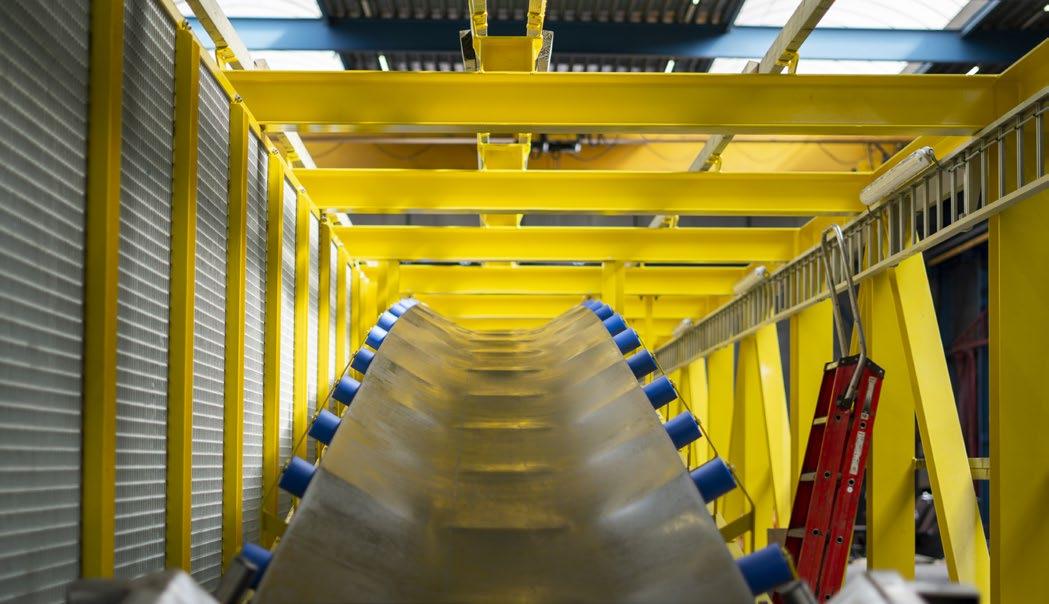
N.M. HEILIG CONSTRUCTED A PARALLEL WORKFLOW, BEGINNING WITH THE CONSTRUCTION OF A NEW SHIPLOADER
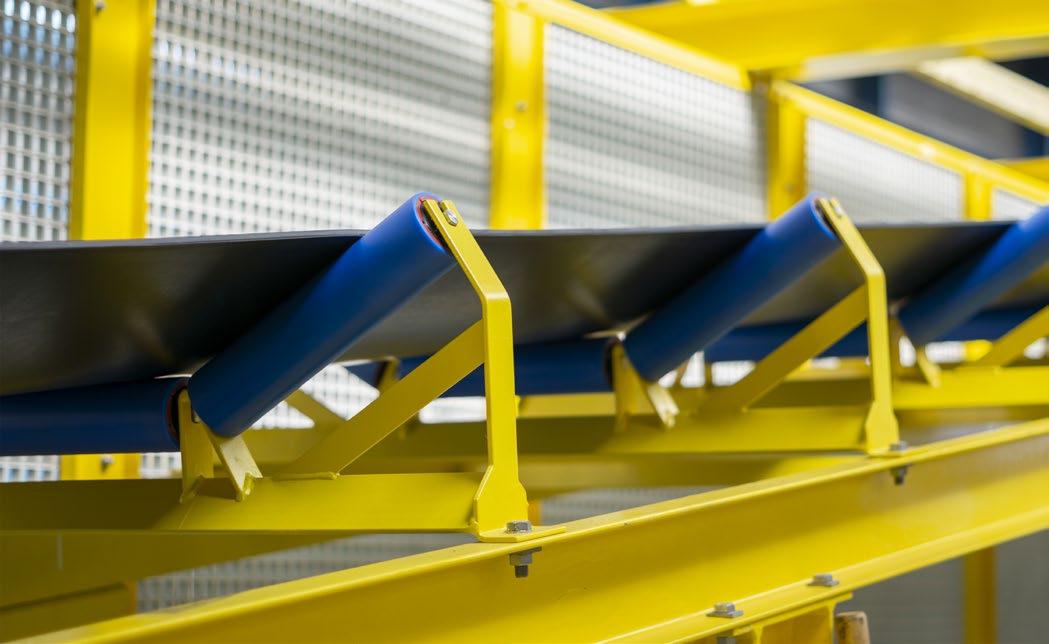

TELESTACK: A MORE MOBILE APPROACH
COMPANY NEWS
The operational success achieved within the mobile sector has gone a long way to highlight the rigidity and limitations of traditional “fixed” operations. The ability to achieve flexibility, efficiency and compliance within any given multicargo port along with the ability to meet all the necessary operational metrics with ease, has prompted a definitive global trend towards mobile equipment in the port.
The introduction of the Telestack AllWheel Travel direct “truck-to-ship” shiploading system has transformed the flexibility and rapidity given to operators, not only in terms of speed (achieved by faster loading rates), but also the agility achieved through the ability to operate and move large scale shiploaders within the limited space on current jetty/docks.
The surge in demand for this type of system encouraged Telestack to develop this concept further with the introduction of a high-rise chassis that enables the unloading truck to drive under the system, opening up a host of options for jetties that are restricted in width (<25m-wide jetty/ dock). The demand for such a system is particularly strong in regions with a developed infrastructure that would not allow for expansion, but where the desire to “move to mobile” exists, based on the level of success achieved by fellow multi-purpose ports.
Telestack International sales manager Carl Donnelly, explains: “Before the development of the ‘high-rise’ system, mobile solutions would not be a viable option for those operations loading handymax or panamax-type vessels. This would render the operator’s equipment selection limited to typical fixed conveyor systems or grab/mobile harbour crane systems. In modern developed ports around the world, where space is such a commodity, certain infrastructures could only consider fixed systems as there was not enough space to allow for mobile operating systems, until the high-rise design eliminated this issue.
“The TB range of radial telescopic shiploaders from Telestack offers a range of mobility features including in-line, parallel travel, radial and steering. This results in the most mobile all-wheel travel system in the market ensuring the unit can move with speed, ease and accuracy from ‘hold to hold’ during the loading operation. The high-rise design allows the unloading truck to drive underneath the shiploader chassis with ease marking a host of options for the compromised jetty.” These all-wheel travel high-rise mobile shiploading systems represent a new generation of mobile solutions, offering the performance of traditional systems, but with the added benefits of mobility, flexibility and, ultimately, a lower cost per tonne achieved by increased production rates, reduced cycle times and reduced labour costs – now within a restricted jetty. The added ability to truly customise the product to the specific needs of the customer, the locality, the commodity and the quayside is yet another reason why the sector was so keen to push for a mobile solution within the restricted jetty.
Telestack offers a level of customisation that is relatively unmatched in the business and it is this level of personalisation that makes it so successful in this area. The ability to incorporate a host of dust containment / extraction options to meet the needs of the local and regional environmental regulations, while ensuring that it can work with
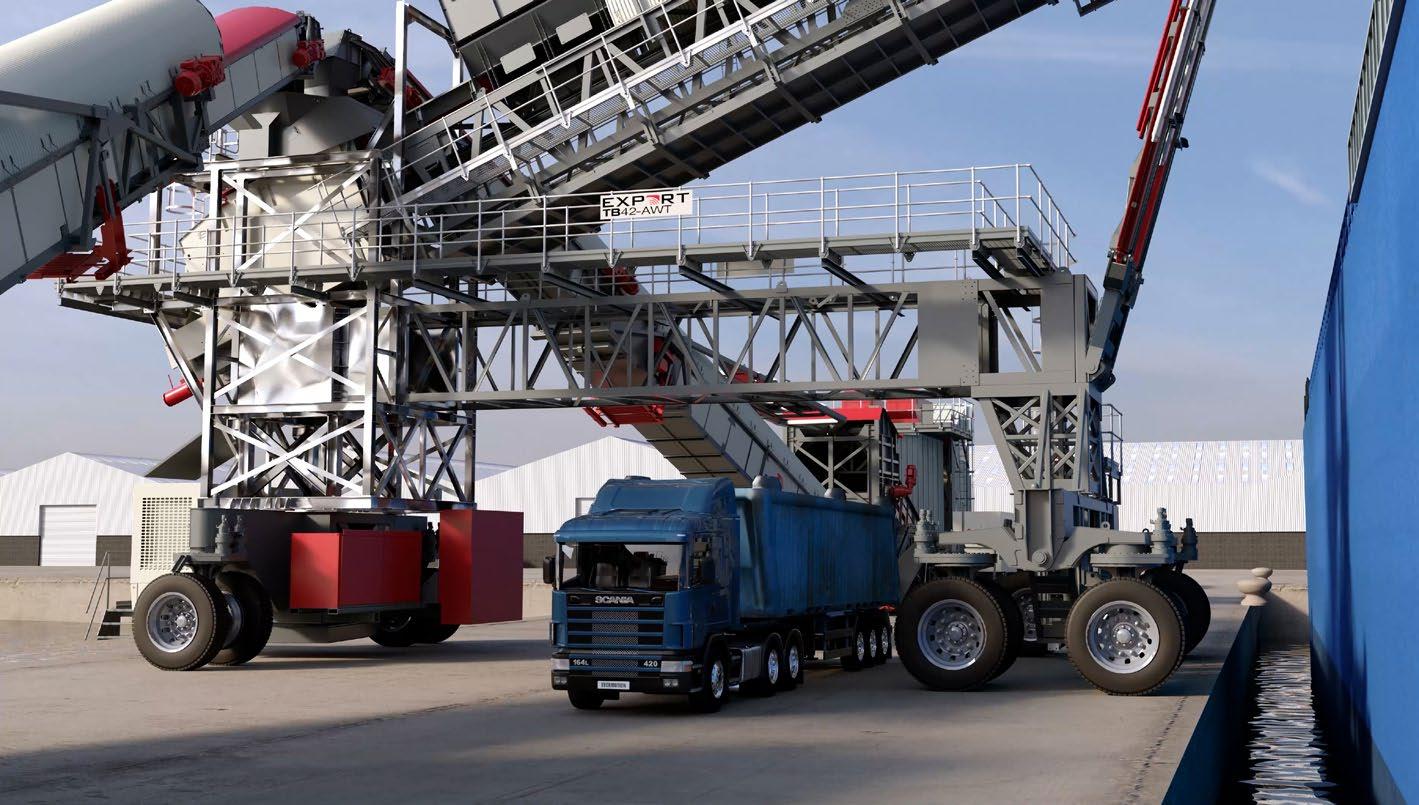
THE INTRODUCTION OF THE TELESTACK ALL-WHEEL TRAVEL DIRECT “TRUCK TO SHIP” SHIPLOADING SYSTEM HAS TRANSFORMED THE FLEXIBILITY AND RAPIDITY GIVEN TO OPERATORS, NOT ONLY IN TERMS OF SPEED (ACHIEVED BY FASTER LOADING RATES), BUT ALSO THE AGILITY ACHIEVED THROUGH THE ABILITY TO OPERATE AND MOVE LARGE SCALE SHIPLOADERS WITHIN THE LIMITED SPACE ON CURRENT JETTY/ DOCKS
more than one material (taking into consideration their differing weights, densities and flow) has meant a truly tailored solution is offered to the customer.
In a recent installation of the high -rise design in South America, the unit was designed with double-sealed dust covers, fully sealed transfer points, dust extraction filters at transfer points, undertrays to prevent any spillage on the jetty, and a 20m telescopic discharge chute to allow controlled trimming of the hold during the loading process. This level of customisation ensures that the system is fully tailored to the environmental needs of the operation.
Telestack is also at the leading edge of electrical sophistication and has a growing and highly skilled electrical team dedicated to ensuring that any Telestack unit can fully integrate into the port’s operating system successfully. In the same installation in South America, the unit was fitted with a customised IP 66-rated diagnostic control panel complete with easy-to- use touch screen. For the operator, who will have to manage several different elements of the shiploading process, the Telestack solution offers the ability to monitor and control the plant from a single location using radio remote control. The integrated generator manages all functions of the shiploader resulting in an autonomous and independent unit with the ability to switch to shore power as and when required.
Telestack’s electrical engineering team is one of the fastest growing departments within the business and the company is continually invested in working with clients to meet their electrical needs. This level of personalisation can also extend to guarding, handrails, dust containment and more.
The need for flexibility to adapt to differing operational needs in the handling of any dry bulk in pit to port, pit to plant or port to plant is important. One of the main reasons for the growth within the mobile sector is the ability to use the same equipment along several parts of the logistics chain. The mobility factor ensures that a company can use the equipment as required in one area of the operation and move to another area with ease and speed, or, indeed, move the units to storage areas, as and when required. This is flexibility that simply cannot be achieved by a traditional fixed infrastructure.
In the current climate where the nature of any given business may have to change in response to changing commodity demands, mobile equipment allows the owner to react quickly. The smart design means that the unit can be easily dismantled, packed into containers and relocated to another site or country as required. The versatility and multi-faceted use in a variety of global applications (sea ports, river terminals, mines, quarries, power plants, cement plants, steel mills, and so on) coupled with excellent resale values ensures there is always a high demand for mobile products.
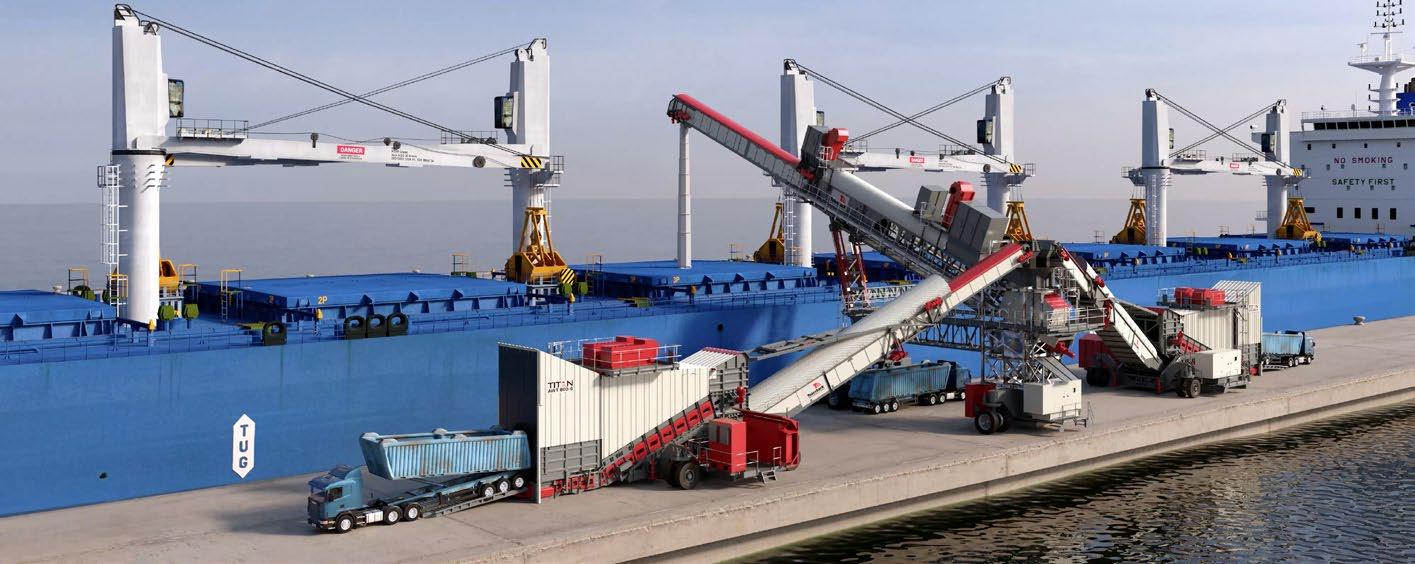
Mobile equipment often helps reduce initial capex as they are typically significantly cheaper to buy than mobile harbour cranes and stationary systems. Such equipment also means there are significantly lower civil engineering and infrastructure costs, and it can easily link into existing material-handling systems. Customers can be generating revenue streams very quickly.
Typically designed to not require any onsite welding, a standard shiploading unit can be transported in several 12m containers and be operational within a few weeks – all with limited/no planning requirements or restrictions as found with stationary solutions. Moreover, the operating costs are significantly less than traditional systems.
The ease of use means that all machines are simple to operate, maintain and troubleshoot as there are no complicated electrics/electronics to manage, and hydraulics can be kept to a minimum. With more than 35 years of experience under its belt and thousands of global installs, Telestack has earned its reputation in the international marketplace for welldesigned and no-nonsense mobile bulk material handling equipment. This reputation as the innovator within the industry is as a result of its long history of bringing real solutions to problems that have long-plagued the industry. As Telestack is part of Astec Industries Group, its customers in South America can rely on local support from Astec-owned facilities in Chile (Santiago) and Brazil (Minas Gerais), as well as a growing network of experienced material handling agents that are focused on supporting the sea ports and river terminals in that and other international regions.
In addition, Telestack’s customers are also benefiting from support from the Telestack helpdesk. With the help of the optional integrated Telematics feature, the helpdesk can support the operation to remotely help troubleshoot any issue in real time. This provision has proved invaluable in the current climate where covid-related restrictions have prevented travel and access to some sites and the operation has benefited greatly from having the additional support from Telestack remotely.
The engineering acumen within Northern Ireland is renowned globally and the expertise within Telestack has grown and developed significantly over their tenure. Its equipment is involved in some of the most ground-breaking and forward-thinking projects across the globe, with the company gaining serious traction in other industries such as rail, power, cement and steel plants.
For more information, contact: telestack.com
THE HIGH-RISE DESIGN OF THIS ALL-WHEEL TRAVEL SHIPLOADING SYSTEM ALLOWS THE UNLOADING TRUCK TO DRIVE UNDERNEATH THE SHIPLOADER CHASSIS WITH EASE OPENING A HOST OF OPTIONS FOR THE COMPROMISED JETTY
